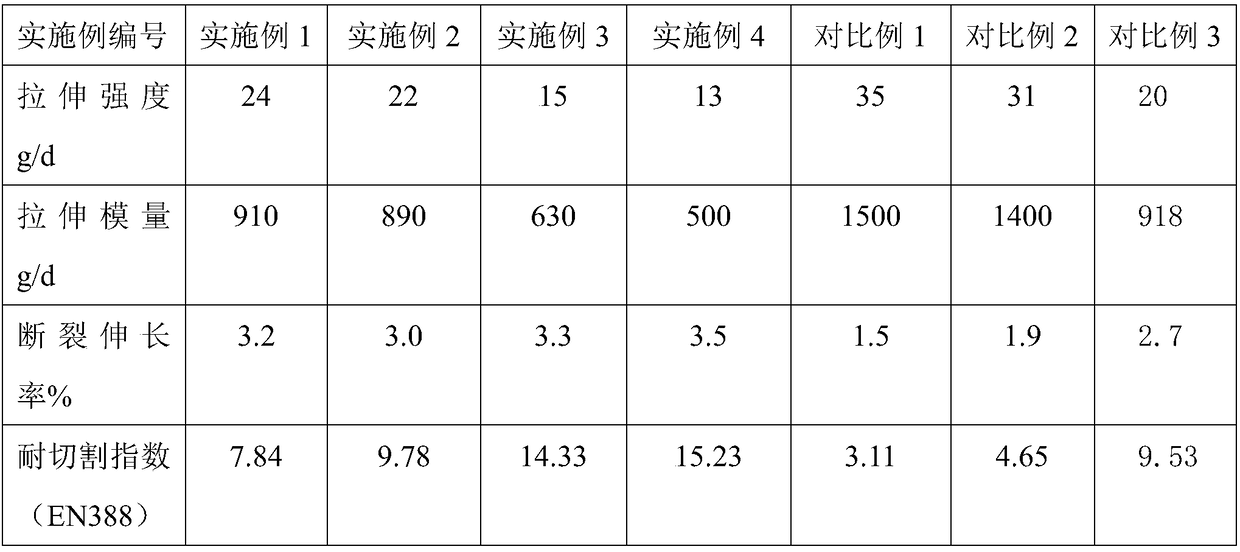Preparation method of anti-cutting polyethylene fibers
A polyethylene fiber, anti-cut technology, applied in the direction of fiber chemical characteristics, single-component polyolefin rayon, rayon manufacturing, etc., can solve the problems of environmental protection, long production cycle, high production cost, etc., to save resources, The effect of low production and processing cost and energy consumption reduction
- Summary
- Abstract
- Description
- Claims
- Application Information
AI Technical Summary
Problems solved by technology
Method used
Image
Examples
Embodiment 1
[0024] Set the molecular weight to 3 x 10 6 8 kg of g / mol polyethylene powder and 0.08 kg of silica-based filler were stirred and mixed at room temperature at a stirring speed of 70 r / min to obtain a mixed raw material. The mixed raw materials are injected into the twin-screw extruder for blending and extrusion, and the extruded liquid is sprayed out through the spinneret hole and then cooled to obtain the raw filament. During the blending and extrusion process, the maximum temperature of the twin-screw extruder is controlled to be 260°C. The obtained raw silk was pre-stretched 1.5 times and then extracted with an extractant, then dried at 40°C for 0.5h, and finally high-stretched at a stretching temperature of 145°C, and cut-resistant polyethylene fibers were obtained after 40-fold stretching.
Embodiment 2
[0026] Set the molecular weight to 3 x 10 6 6 kg of polyethylene powder in g / mol and 0.8 kg of silica-based filler were stirred and mixed at room temperature at a stirring speed of 60 r / min to obtain a mixed raw material. The mixed raw materials are injected into the twin-screw extruder for blending and extrusion, and the extruded liquid is sprayed out through the spinneret hole and then cooled to obtain the raw filament. During the blending and extrusion process, the maximum temperature of the twin-screw extruder is controlled to be 260°C. The obtained raw silk was pre-drawn 1.5 times and then extracted with an extractant, then dried at 40°C for 0.5h, and finally high-stretched at a stretching temperature of 120°C, and cut-resistant polyethylene fibers were obtained after 25-fold stretching.
Embodiment 3
[0028] Set the molecular weight to 3 x 10 6 6 kg of g / mol polyethylene powder and 1.2 kg of silica-based filler were stirred and mixed at room temperature at a stirring speed of 85 r / min to obtain a mixed raw material. The mixed raw materials are injected into the twin-screw extruder for blending and extrusion, and the extruded liquid is sprayed out through the spinneret hole and then cooled to obtain the original filament. During the blending and extrusion process, the maximum temperature of the twin-screw extruder is controlled to be 320°C. The obtained raw silk was pre-drawn 1.5 times and then extracted with an extractant, then dried at 40°C for 0.5h, and finally high-stretched at a stretching temperature of 145°C, and cut-resistant polyethylene fibers were obtained after 30-fold stretching.
PUM
 Login to View More
Login to View More Abstract
Description
Claims
Application Information
 Login to View More
Login to View More - Generate Ideas
- Intellectual Property
- Life Sciences
- Materials
- Tech Scout
- Unparalleled Data Quality
- Higher Quality Content
- 60% Fewer Hallucinations
Browse by: Latest US Patents, China's latest patents, Technical Efficacy Thesaurus, Application Domain, Technology Topic, Popular Technical Reports.
© 2025 PatSnap. All rights reserved.Legal|Privacy policy|Modern Slavery Act Transparency Statement|Sitemap|About US| Contact US: help@patsnap.com

